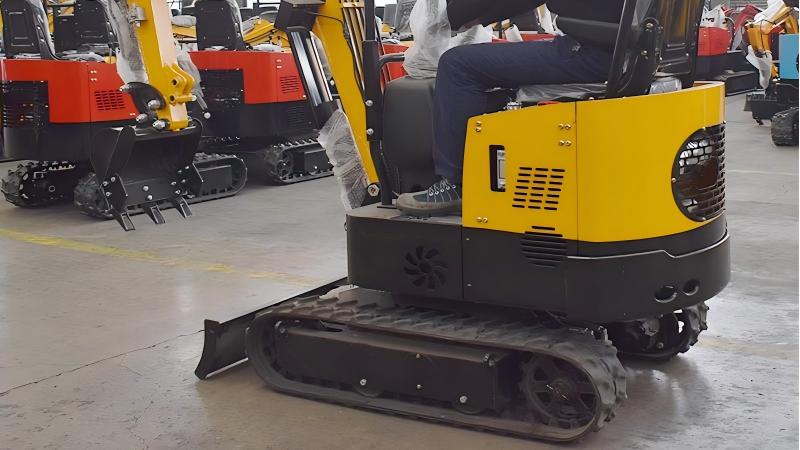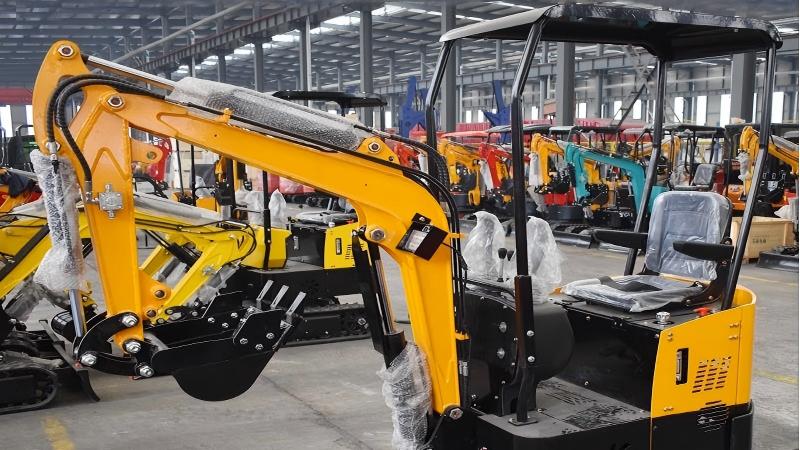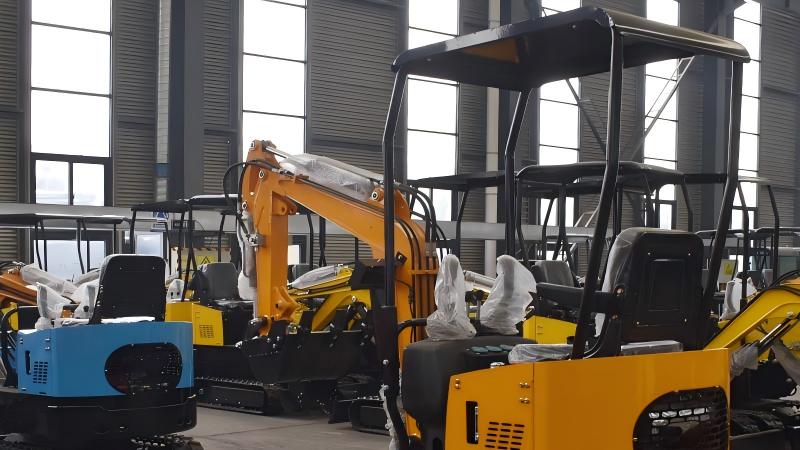Mini excavators have revolutionized the construction, landscaping, and utility industries by offering powerful digging and earthmoving capabilities in a compact form factor. While the term "mini" itself implies small size, the industry has pushed the boundaries further, developing "micro" excavators that can fit into incredibly tight spaces, even through standard doorways. Determining "the smallest mini excavator available" can be tricky, as various manufacturers vie for this title, and the definition of "smallest" might refer to weight, width, or overall dimensions. However, a few models consistently stand out in the ultra-compact class.
Defining "Smallest" in Mini Excavators
When discussing the smallest mini excavators, we typically refer to machines with an operating weight under 1 metric ton (approximately 2,200 pounds or 1,000 kg). These machines are often characterized by:
Narrow Width: Their most defining feature is their ability to retract their tracks and blade to fit through narrow openings, often as little as 28-30 inches (70-76 cm).
Low Operating Weight: This makes them easily transportable on a standard utility trailer, often towed by a pickup truck, avoiding the need for specialized transport.
Compact Dimensions: Short overall length and height, often with foldable ROPS (Roll-Over Protective Structure) bars, allow them to work in extremely confined areas and gain access to basements or interior demolition sites.
Limited Digging Depth and Reach: While powerful for their size, their digging capabilities are naturally less than larger mini excavators.
Leading Contenders for the Smallest Mini Excavator Title
Several manufacturers produce excellent ultra-compact excavators. Among the most frequently cited models are:
Kubota K008-3: The Kubota K008-3 is a long-standing and highly respected contender in the micro excavator segment. It's renowned for its reliability and ability to tackle demanding tasks in tight spaces.
Operating Weight: Around 2,200 lbs (980-998 kg).
Overall Width: Its key feature is the adjustable track width, which can retract to a mere 2 feet 10 inches (86 cm) and expand for stability. Some sources even cite a retracted width of 2 feet 4 inches (71 cm).
Dig Depth: Approximately 5 feet 8 inches (1.72 m).
Engine Power: Around 10.2 horsepower.
Key Features: Retractable undercarriage, foldable ROPS, and strong digging force for its class. It's often praised for its smooth hydraulics and operator comfort despite its size.
Caterpillar 300.9D (and 300.9D VPS): Caterpillar's entry into the micro excavator market is the 300.9D, known for its robust build and the "VPS" (Versatile Power System) variant that allows for an optional electric power unit.
Operating Weight: Around 2,061 lbs (935 kg) for the standard 300.9D, and 2,399 lbs (1088 kg) for the 300.9D VPS.
Overall Width: Features an overall width of approximately 2 feet 5 inches (730 mm), which can be retracted.
Dig Depth: Roughly 5 feet 8 inches (1.73 m).
Engine Power: Around 13 horsepower.
Key Features: Its extremely narrow width allows it to pass through standard doorways. The VPS option offers zero-emission operation, ideal for indoor work. It also has an extending undercarriage for stability.
JCB 8008 CTS: JCB offers the 8008 CTS, a micro excavator designed for high performance in restricted areas, including within buildings and small gardens.
Operating Weight: Approximately 1,929 lbs (875 kg) transport weight, with an operating weight of 2,094 lbs (950 kg).
Overall Width: Retracts to 2 feet 3 inches (700 mm) and extends to 2 feet 10 inches (865 mm).
Dig Depth: Around 5 feet 6 inches (1.69 m).
Engine Power: Around 12.7 horsepower.
Key Features: Exceptional compactness, an extending undercarriage for stability, and surprisingly strong digging and lift capacities for its class. JCB also offers an electric version, the 8008E.
Other Notable Small Excavators
While the above three are often cited as the absolute smallest, other manufacturers also produce highly compact excavators that deserve mention:
Bobcat E10 / E10e (Electric): The Bobcat E10 is another popular choice for tight access jobs, with an operating weight around 2,593 lbs (1,176 kg) and a retractable undercarriage that can reduce its width to 28 inches (71 cm). The E10e offers electric, zero-emission operation.
Hinowa DM 8: Hinowa is known for its compact construction equipment, and their DM 8 is a micro excavator with a reported weight of 0.85 tons (1,874 lbs) and a transport width of 0.78 meters (30.7 inches).
Kobelco SK007: This model from Kobelco is also very compact, with a reported weight of 0.73 tons (1,609 lbs).
Features that Define "Smallest" and Their Benefits
The pursuit of the "smallest" mini excavator is driven by the need to work in environments inaccessible to larger machines. Key features that enable this include:
Retractable Undercarriage: This allows the tracks to narrow, enabling the machine to pass through standard doorways, gates, and tight alleyways. Once through, the tracks can be extended for increased stability during operation.
Foldable ROPS/Canopy: The safety roll-over protective structure (ROPS) or canopy can often be folded down, significantly reducing the machine's transport height, allowing it to fit into vans, trailers with height restrictions, or under low ceilings.
Zero or Minimal Tail Swing: Many of the smallest excavators feature zero or minimal tail swing designs, meaning the counterweight does not extend beyond the width of the tracks when the machine rotates. This is crucial for working flush against walls or in extremely confined spaces without damaging surroundings.
Hydraulic Auxiliary Lines: Even the smallest excavators come with auxiliary hydraulic lines, enabling them to power various attachments like hydraulic breakers, augers, grapples, and trenching buckets, expanding their versatility.
Easy Transportability: Their low weight means they can be easily transported on small trailers, reducing transportation costs and logistics complexity.
Applications of the Smallest Mini Excavators
These micro excavators are indispensable for a wide range of tasks where larger equipment simply cannot fit:
Indoor Demolition: Their ability to pass through doorways makes them ideal for breaking up concrete, removing walls, and other demolition tasks inside buildings, minimizing manual labor.
Landscaping in Residential Areas: Perfect for backyard projects, digging trenches for irrigation or drainage, creating garden beds, removing small stumps, and excavating for patios or small ponds where space is limited and property damage needs to be minimized.
Utility Installation and Repair: Digging narrow trenches for electrical conduits, gas lines, water pipes, or fiber optic cables in urban areas or tight easements.
Basement Excavation: Removing soil for basement renovations or new basement construction where access is restricted.
Cemetery Work: Digging graves in tight spaces between existing monuments.
Tight Access Construction Sites: Working on congested construction sites where space for machinery movement is extremely restricted.
Agricultural Applications: Small-scale trenching, fence post hole digging, and clearing in small farms or orchards.
Conclusion
While the absolute "smallest" mini excavator can be a moving target as manufacturers continuously innovate, the Kubota K008-3, Caterpillar 300.9D (and VPS), and JCB 8008 CTS consistently represent the forefront of ultra-compact excavation technology. These machines, with their ability to navigate incredibly tight spaces, offer unparalleled versatility for niche applications. They demonstrate that power and efficiency are not solely dependent on size, providing essential solutions for tasks that would otherwise require intensive manual labor or be impossible to complete with larger equipment. For contractors, landscapers, and utility workers facing confined work environments, these smallest mini excavators are invaluable tools that significantly enhance productivity and safety.
Post time:Sep-25-2020



